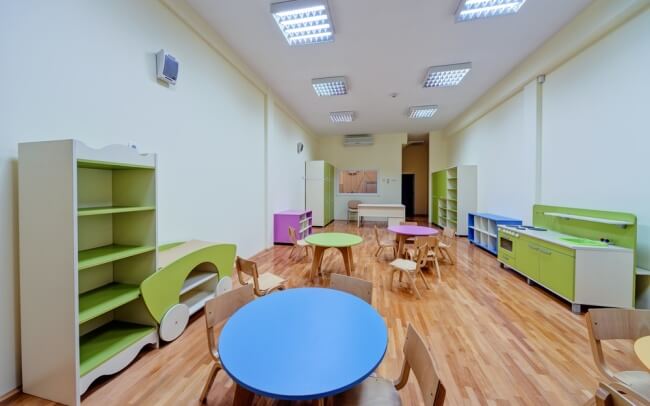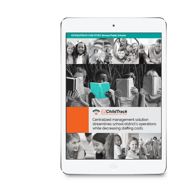
There seems to be one thing kids share unstintingly, and that's germs. Every surface of your classrooms, play areas, lunchroom, and toys is assaulted on a daily basis. There's just no getting around it.
Keeping your daycare center clean is an ongoing struggle, one you wage every day. But what is meant by clean and what needs to be cleaned and when?
The Difference between Cleaning, Sanitizing, and Disinfecting
Cleaning a daycare facility means more than cleaning. Some areas must be sanitized, and others disinfected.
- Cleaning - washing with mild detergent and water to remove visible dirt, soil, and debris from surfaces. You cannot effectively disinfect or sanitize if dirt is in the way. Scrub, wash, and rinse each surface before proceeding.
- Sanitizing - covering the cleaned area with a sanitizing solution such as bleach or sanitizer with EPA registration label and allowing it to air dry. Dishes, food contact surfaces, toys that children put in their mouths, and more must be sanitized after cleaning.
- Disinfecting - covering the cleaned area with a disinfecting solution such as bleach or ammonia. CAUTION: NEVER MIX BLEACH AND AMMONIA. Allow the area to air dry or follow the manufacturer’s recommendation before wiping it off. Disinfect diapering areas, bathrooms, and anyplace bodily fluids have touched.
The point to all this cleaning, disinfecting, and sanitizing is to reduce the number of bacteria and viruses as much as possible to prevent illness from spreading.
Disinfecting is included in state child care licensing regulations in most states. Be sure to review and follow the rules of your state licensing agency. Rules cover acceptable disinfecting solutions, the use of laundry washers and dishwashers, and water temperatures.
How to Disinfect or Sanitize
For tables and other large items, once you clean them of dirt and soil, disinfect with a spray bottle of sanitizing or disinfecting solution, wiping the liquid evenly across the surface and allowing it to dry. Unless the manufacturer’s instructions on the disinfectant container say otherwise, do not wipe the area dry; disinfectant works best when allowed to sit without disturbance. By the time the liquid dries enough time has passed to ensure most bacteria and viruses are killed.
For dishes and plastic toys, sanitize the items in your dishwasher. A dishwasher can apply water at temperatures higher than your hands can stand as well as use the appropriate sanitizing solution as part of the cycle. Some dishwashers have a sanitize setting that cleans at higher temperatures or may use a different solution from regular washing.
Linens and clothing can be disinfected in the washing machine. Purchase items that can withstand hot water, disinfecting solutions, and repeated laundering without fading or becoming prematurely worn.
A Caution about Commercial Disinfectants
- Before using a “hospital grade” germicide, read the product label carefully. Many are dangerous and potentially toxic to children.
- Do NOT use cleaning products labeled DANGER or CORROSIVE.
- Before using any other disinfectant or sanitizer than a bleach and water solution, check with the childcare nurse consultant or licensing agency to ensure it is acceptable for use in a childcare setting. Always follow the manufacturer’s instructions when using an EPA-approved industrial product as a sanitizer.
Areas to Clean
The easiest way to ensure thorough cleaning is to follow a schedule and clean areas in the same order every day. Any surface with visible soil, especially bodily fluids, should be cleaned and disinfected immediately.
Each day clean the entryways including the door handles, light switches, pens and pencils, cubbies, floors, walls, railings, phones, and keyboards.
The diaper changing area must be disinfected between each diaper change. The provider must also wash hands between each diaper change, even when using gloves. Gastrointestinal illnesses caused by rotavirus and norovirus are easily spread and can cause dangerous diarrhea resulting in dehydration.
Wipe play area shelves, play centers, and play surfaces. Some toys can also be wiped clean but smaller, durable toys can be washed in a dishwasher. Washable toys, linens, and bedding should be washing in the washing machine using chlorine or non-chlorinated bleach as appropriate.
In the bathroom, clean the sinks, toilets, floors, rugs, doorknobs, and light switch. Kitchen floors, faucet, refrigerator handles, stools, tables, counters, trash cans, chairs (including high chairs), and bibs must be cleaned.
Other areas that may need additional attention include doorknobs throughout the center, shared keyboards, drinking fountains, faucet handles, toilet levers, toys, and nap mats. Any surface liable to be touched by a child during the course of the day must be cleaned and disinfected or sanitized.
The NAEYC publishes a frequency table with recommendations for cleaning your facility.
Tips on Cleaning Your Daycare Center
- Immediately clean up any spills.
- Vacuum daily.
- Clean the bathroom before opening in the morning.
- Use a hands-free covered trash can in each room.
- Keep a container to place items that need to be washed such as toys that have been chewed, paint brushes and trays, and other frequently soiled items.
- If allowed by state regulations, some types of disinfecting wipes may make cleaning chores easier.
To find disinfecting wipes that meet state licensing requirements, check the label to ensure that Staphylococcus aureus, Escherichia coli O157: H7, Salmonella enterica, Streptococcus pyogenes, Human Coronavirus, and Influenza virus are killed by the disinfectant in question.
Maintaining Supplies
A childcare management software solution can help you maintain supplies, so you don't run out. If you ask parents to provide cleaning supplies, use the parent portal to message parents at the appropriate times to request refills and other cleaning supplies. You can include the type of supplies and the amount in a monthly email. If you are requesting different supplies from different sets of parents, a separate notification can be crafted for each group.
Childcare management software allows you to send immediate notifications via text as well if there is a health emergency such as the spread of the flu or if a child has exposed others to a communicable disease. If a child must go home, the emergency phone number and list of persons allowed to pick up the child are easily accessible.
Keeping your daycare center clean is a critical daily activity you must undertake to maintain health and wellness for your children. Cleanliness is of primary concern to parents and one of the items they check on tours.
Use the appropriate cleaning, disinfecting, and sanitizing procedures and materials to keep everything sparkling clean and ready for fun every day.




